CHAPTER 9
Texas International Pop Festival, 1969
 AUGUST 1969, three days of acid, peace and love, hippies and music. It can only be one thing, right? Perhaps not: just two weeks after Woodstock came the Texas International Pop Festival.
AUGUST 1969, three days of acid, peace and love, hippies and music. It can only be one thing, right? Perhaps not: just two weeks after Woodstock came the Texas International Pop Festival.
Nowhere town Lewisville was the host to 120,000 hippies, as well as Led Zep, Grand Funk Railroad, BB King and Janis Joplin for the Labor Day weekend in August 1969. The festival took place on the now-defunct speedway track and was distinguished by a scorching, hard, bluesy Led Zeppelin set.
Texas had its first taste of the Zep a month previously when they played in Dallas and Houston and this performance showed a band on the up, coming between their first and second albums. Hard and horny versions of ‘Train Kept A Rollin’ and ‘I Can’t Quit You Baby’ kicked off a sweaty, thumping set that featured a tremendous ‘Dazed And Confused’ and served notice to America of a major new force in blues rock.
If the night-time belonged to Zep, there was plenty to enjoy in the daytime too. Local residents were shocked –SHOCKED! – to see hippies skinny-dipping in Lake Lewisville. Some of them were so shocked that they had to get in boats to have a closer look at the naked boobies, which were officially the most exciting thing to happen to Lewisville Texas in a generation. Naked hippies; you can’t beat ‘em.
The town was blessed, or rather the festival was blessed, with an unusually tolerant police chief, who had the foresight to see that a non-confrontational approach to the longhairs would pay dividends. Maybe it helped that Chief Ralph Adams was leaving his job that summer, but he managed to preside over an event that saw just a couple of dozen arrests out of 120,000 punters.
To give you an idea of how mellow it was – certainly when you compare that Altamont was only four months in the future – Kesey’s right-hand man Ken Babbs ran a free stage, security was handled by the ‘Please Force’ and Wavy Gravy offered counselling for those who had overdone it on the mind-bending drugs. The clown/activist/icon/pharmaceutical experiment, in association with activist commune Hog Farm, also dished out free food. In fact, Wavy Gravy got his name, one of the great loon monikers – from no less a personage than BB King, who played for three nights here, when the blues legend found him lying on the stage.
The event also saw Janis Joplin return to Texas and get the sort of rousing reception from her home-state crowd that had not always been the case.
Grand Funk Railroad, then relative unknowns, opened the festival for free, confident that the exposure would be well worth it. Selling more albums than any other US band in the following year (1970) suggested it was a shrewd move.
Other blues rock big guns playing included Chicago and Johnny Winter (check out the album of his set – he’s on the form of his life), while Sly And The Family Stone closed the festival with ‘Hot Fun In The Summertime’. And indeed it was.
 If Lewisville was a peaceful, innocent celebration of the hippie ideal, it was to be one of the last gasps of it, too. The dark disaster of Altamont in December of the same year seemed to sound the death knell.
If Lewisville was a peaceful, innocent celebration of the hippie ideal, it was to be one of the last gasps of it, too. The dark disaster of Altamont in December of the same year seemed to sound the death knell.
But in the first half of 1970, plans were nonetheless afoot for a festival in Middlefield, Connecticut. So here’s a quiz question: what was so special about the July 1970 rock festival at Powder Ridge Ski Area, which was attended by around 30,000 people?
Answer: the event was cancelled. The establishment got pretty wise, pretty quickly after Woodstock and the fun of 1969, and local communities mobilised to prevent tens of festivals in 1970. Festivals were seen as political events, and one such that could not get its legal injunction was Powder Ridge, which had booked Joe Cocker, Janis Joplin, Sly Stone, James Taylor, Fleetwood Mac, Chuck Berry and others. But the mere fact that the event wasn’t going ahead didn’t stop the promoters from promoting it.
30,000 souls were not going to let such inconveniences as a cancelled festival spoil their weekend and turned up anyway, leading to one of the most heroic displays of mass public drug-taking the continental US had ever seen. Without the distractions of bands to see – with the exception of a few local outfits like Melanie.
Drugs, lots of bad drugs, were the order of the day, with dealers hawking their wares untroubled: “Buy a tab of acid and get a shot of heroin free”, they shouted. You don’t get that in Boots.
Festival medic William Abruzzi was treating 50 freaking out trippers an hour amid scenes of considerable wigging out. Connecticut – not exactly known as a party state – hadn’t seen anything like it. When the Black Panthers got involved to protest the 1970 BP trials that were taking place in New Haven, it was clear that this wasn’t your average festival. When people started dumping drugs into the barrels of drinking w ater, plots were being lost left, right and I-can’t-feel-my-face centre.
When the Black Panthers got involved to protest the 1970 BP trials that were taking place in New Haven, it was clear that this wasn’t your average festival. When people started dumping drugs into the barrels of drinking w ater, plots were being lost left, right and I-can’t-feel-my-face centre.
Not a good day for The Kids.
CHAPTER 10
Castle Donington 1980
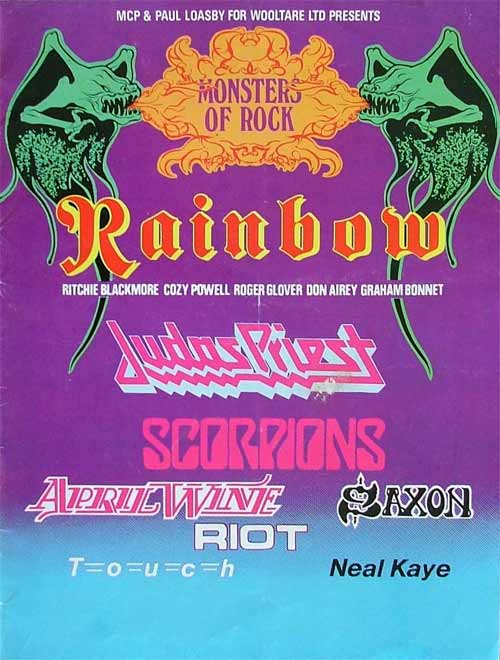 A MOTOR-RACING TRACK in Leicestershire might not be the most inspiring venue in the world, but it played host to anyone who is anyone in hard rock and metal for a decade and a half. It is, of course, Castle Donington Raceway and the event is the Monsters Of Rock festival.
A MOTOR-RACING TRACK in Leicestershire might not be the most inspiring venue in the world, but it played host to anyone who is anyone in hard rock and metal for a decade and a half. It is, of course, Castle Donington Raceway and the event is the Monsters Of Rock festival.
In 1980, the one-day event immediately established itself as a metal challenger to the Reading festival by booking Rainbow, Judas Priest, Scorpions and Saxon. Completing the seven band line-up were April Wine (from Canada – who I saw at Newcastle City Hall in all their cheesy spandex glory touring the Harder… Faster album) and Riot and Touch (both from New York City). Neal Kay, champion of the burgeoning New Wave Of British Heavy Metal movement, was the DJ.
Official attendance was given as being around 35,000. It had rained in the days leading up to the event but the 16 August itself wasn’t bad at all. The event was promoted by Paul Loadsby – who had also been promoting Rainbow’s tour that summer – and was pretty well organised. And you could take your own drink in. That’s the spirit. There was even one of them newfangled video screens.
Space age giant tellies aside, there were some technical difficulties in the warm up that would not have shamed a Spinal Tap outtake, when the PA system was damaged during tests for Cozy Powell’s pyrotechnics. The legendary drummer had good reason to want to go out with a bang: this was to be his last gig with Rainbow as he had grown disillusioned with the direction Ritchie Blackmore was taking the band. But more of them in a minute. How brilliant, though: to knacker the PA because you were playing with fireworks. It has been claimed that the explosion could be heard three miles away. Just a surprise that there wasn’t a freak gardening accident.
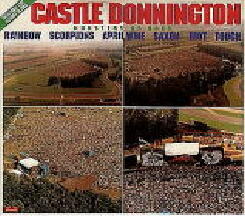 It wasn’t the only weird mishap at the event: the bassist of second-on-the bill Riot – who were the pet project of Neal Kay – had the misfortune to swallow a BEE while on stage. Not in the Ozzy Osbourne manner, biting its head off, though: the buzzing chum just flew into his gob mid-song.
It wasn’t the only weird mishap at the event: the bassist of second-on-the bill Riot – who were the pet project of Neal Kay – had the misfortune to swallow a BEE while on stage. Not in the Ozzy Osbourne manner, biting its head off, though: the buzzing chum just flew into his gob mid-song.
After the two American acts, it was into the meat and drink of the event: The New Wave Of British Heavy Metal. Saxon were the first band with a real following, as a result of their recent success with Wheels Of Steel and 747 (Strangers In The Night). Always wondered if that record freaked out any misdirected Sinatra fans. Barnsley’s finest were in good form and got the crowd going nicely. This was a band on the up – the next years saw them release Denim And Leather, arguably the classic NWOBHM record.
April Wine played next, the highlight being their ‘I Like To Rock’ – which is featured on the excellent live album of the event Castle Donington 1980 – 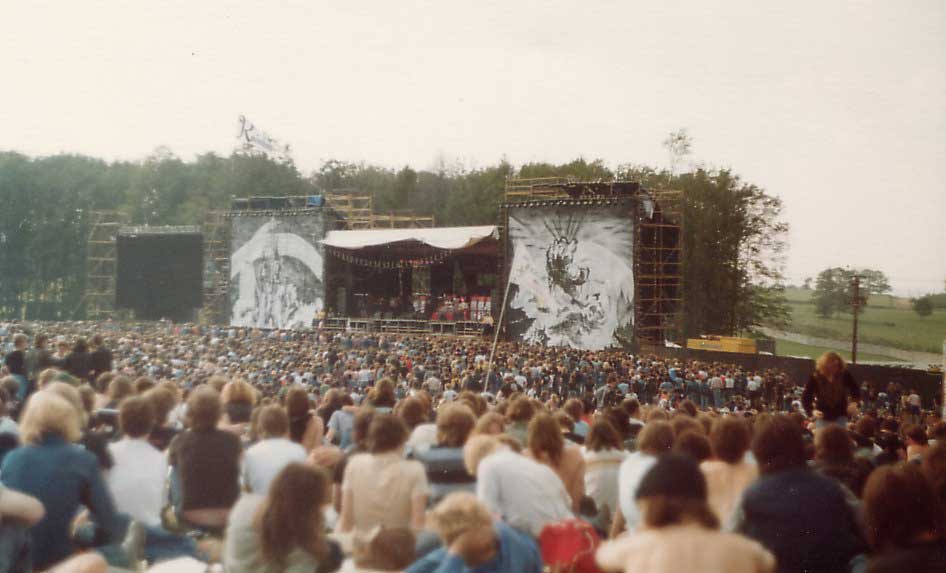 Monsters Of Rock. It’s got two tracks from Rainbow and Scorpions and one each from the other bands, with the exception of Judas Priest who were bringing out a live album of their show and didn’t want to steal their own thunder. Worth remembering that Priest were probably at their peak of popularity at this time and we still didn’t know Rob was gay!
Monsters Of Rock. It’s got two tracks from Rainbow and Scorpions and one each from the other bands, with the exception of Judas Priest who were bringing out a live album of their show and didn’t want to steal their own thunder. Worth remembering that Priest were probably at their peak of popularity at this time and we still didn’t know Rob was gay!
After Canada came Germany. The younger generation might think of Scorpions first and foremost as the purveyors of earnest Berlin Wall ballad Wind Of Change. But in the days before they learned how to whistle, the hard rockers from Hanov er could play a stonking live set – notably on ‘Another Piece Of Meat’.
The real big guns came out, though, when Judas Priest arrived. Rob Halford took to the stage on a massive Harley, and the crowd were ready to go. Funnily enough, he did the same thing at Donington this year when the Priest played at Donington’s Download Festival. Doesn’t quite have the same ring as Monsters Of Rock, does it?
Anyway, the Judas Priest set was a stormer. They had been around for a while by then, but were right back in the forefront of the British scene thanks to 1980’s British Steel and the crowd were well up for it. They opened up with ‘The Ripper’ and played a belting take on ‘Living After Midnight’ – check out the live album of their performance.
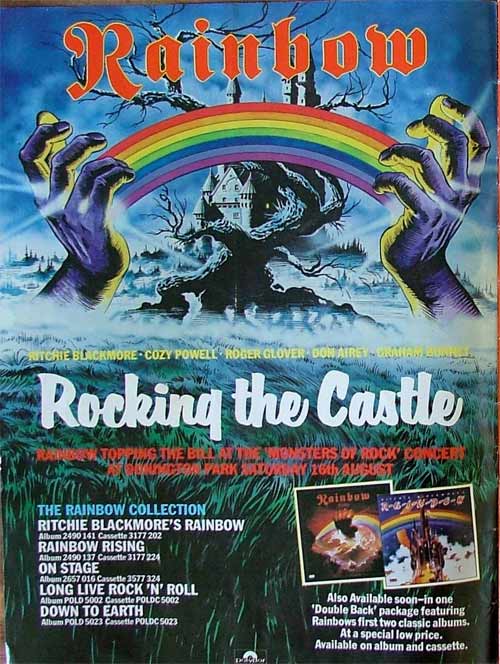 Headliners Rainbow were brilliant. The energy and connection with the crowd in ‘All Night Long’ is just great, as was the unlikely and brilliant cover of Carole King’s ‘Will You Still Love Me Tomorrow’. The guitar work on Kill The King is stunning, just before Ritchie trashed his guitar and blew up a Marshall stack (although he’s smart enough to change his Fender Strat for what looked like some sort of dodgy stunt guitar with a very short life expectancy).
Headliners Rainbow were brilliant. The energy and connection with the crowd in ‘All Night Long’ is just great, as was the unlikely and brilliant cover of Carole King’s ‘Will You Still Love Me Tomorrow’. The guitar work on Kill The King is stunning, just before Ritchie trashed his guitar and blew up a Marshall stack (although he’s smart enough to change his Fender Strat for what looked like some sort of dodgy stunt guitar with a very short life expectancy).
Singer Graham Bonnet was wearing a pair of tight red trousers, a pink shirt and a sort of white boating blazer. Particularly next to Blackmore (all hair and rock God black blousy thing) he looked like he’d wandered in off the set of Miami Vice. No wonder this was also his last gig with Rainbow although, unlike Cozy, he didn’t know it at the time. Cozy’s drum solo was totally balls-out, and the version of ‘Stargazer’ was terrific as well. Rainbow, much like Purps gigs usually revolved around how hot Blackmore was: here he was on rip-snorting form; the sort of radical guitar noise and humongous riffs that were his unique gift to rock ‘n’ roll dripping from his fingers.
The event was a big gamble by the promoters – to have a purely metal line-up – and was a defining moment in the NWOBHM movement. Although not a financial success in itself, it paved the way for the Monsters Of Rock festivals for nearly two decades and proved that metal could carry a festival on its own terms. Still no news on that poor bee though.
CHAPTER 11
Watkins Glen 1973

The 1973 Summer Jam at Watkins Glen in Upstate New York was the brainchild of Shelly Finkel and Jim Koplik, promoters who worked mainly out of nearby Connecticut. They had put on a successful concert with the Grateful Dead the year before where, by a happy accident, some of the Allman Brothers Band had been backstage. They came onstage in Hartford for an impromptu jam, to the mutual satisfaction of the two bands – and the Deadheads.
Finkel and Koplik mooted a possible joint outdoor gig the following summer and both bands were keen – especially when the promoters started talking the big numbers. The Dead would earn $117,000 for Watkins Glen, then their biggest career paydate.
They needed a third act and signed up The Band – who were ready to play out again after an 18-month layoff for studio work. And as they were living in the New York St ate area it all added up.
who were ready to play out again after an 18-month layoff for studio work. And as they were living in the New York St ate area it all added up.
The Watkins Glen Raceway provided the venue. Because the race track was well-used to handling large numbers of visitors, and it was only a one-day event and the slick promoters convinced the powers-that-be that this wasn’t going to be one of those goddamn hippy things with mindfreaked longhairs wandering around for a week and going on about Vietnam, there was relatively little local opposition and bureaucratic hassle.
Two weeks prior to the Saturday 28 July date, 100,000 tickets had been sold at ten bucks a piece and the promoters sought and gained permission to sell another 25,000 on the day. Problem was, people started arriving early. Really early. Some were turning up a full week before; by the Wednesday, police reckoned there were 50,000 already camping. Double by the next day.
Come the Friday afternoon there were maybe 250,000 people there, and the traffic was queuing back 50 miles! The cops started turning back people without tickets, and even some who did have them. Harsh.
When the Dead came to soundcheck on Friday afternoon, there were 100,000 people in front of the stage. What you gonna do? Well, it turned into an impromptu gig and, The Dead being The Dead, they played for two hours, occasionally stopping to sort out sound but basically playing a bonus gig. Not to be outdone, the Allman Brothers and The Band also played for an hour or two each.
Awesome, but the main event, of course, was the next day. The Dead played first, a beautiful, mesmeric five-hour performance of two sets, opening with ‘Bertha’ Their Wall Of Sound was simply immense, Jerry’s guitar smooth as silk. ‘Truckin’… ‘China Cat Sunflower’… ‘Stella Blue’… ‘Sugar Magnolia’. It was a good day to be a Deadhead.
 The Band played next but were interrupted an hour into their set by a storm. As it cleared, a tragic accident marred the day, wh en a skydiver, carrying flares (like incendiary devices, not trousers) got into trouble while parachuting. The flares combusted in the air, engulfing him in flames, rendering him unable to operate his parachute and causing him to fall to his death.
The Band played next but were interrupted an hour into their set by a storm. As it cleared, a tragic accident marred the day, wh en a skydiver, carrying flares (like incendiary devices, not trousers) got into trouble while parachuting. The flares combusted in the air, engulfing him in flames, rendering him unable to operate his parachute and causing him to fall to his death.
The Band came back on, but it was hard for them to get going. Nevertheless, it was an accomplished performance, sleek and hard, some of which is captured on the Band Live At Watkins Glen live record – although the provenance of some tracks on that is questionable. It saw them premiere ‘Endless Highway’, play Dylan’s ‘Don’t Ya Tell Henry’ and Chuck Berry’s ‘Back To Memphis’. Garth Hudson’s organ-playing is mighty fine.
The Allman Brothers played last and turned in a superb performance, the highlight of which was ‘In Memory Of Elizabeth Reid’. Afterwards, Robbie Robertson, Jerry Garcia and others joined for a jam featuring ‘Not Fade Away’ and ending in a barnstorming version of ‘Johnny B. Goode’.
It’s said that the event was so big that 1 in 350 Americans was at the gig that weekend! But Watkins Glen does not have the same place in rock folklore as Woodstock. The 1969 gig was, among other things, a political act, in a way that Watkins Glen was not. The withdrawal from Vietnam was well underway, there seemed to be fewer battles to fight, maybe. The politicisation of pop music was not high on the agenda of so many bands. By all accounts, there was less LSD and hard drugs, more pot and booze at Watkins Glen. The overall vibe – peaceful and inclusive though it might have been – was more that of a great party than a social movement or era-defining experience.
Yet it certainly changed rock, if not society. Promoters across the US saw that there was serious money to be made from one-day festivals and soon, the ABC television network were getting in on the act. California Jam the following year attracted 200,000 and was a slick, well-organised, profitable success – and a definite staging post on the journey to rock corporatisation. It ushered in the era of rock stars arriving by private helicopter and big bucks, and in its own way, Watkins Glen was one of the precursors to that. Still, none of that is what anyone there, or anyone listening on record, is thinking about when Jerry Garcia is doing ‘Playing In The Band’.
CHAPTER 12
Reading Festival 1973
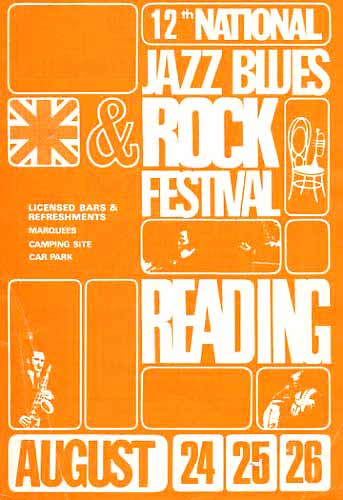 THE READING AND LEEDS FESTIVALS of today are the UK’s longest-running events of their type, and evolved out of the National Jazz And Blues Festival, which was born all the way back in 1961. Not much jazz on the bill these days and, in truth, by the early 1970s it was on the outs – although there was a brief outbreak of syncopation in 1973 with the cultish booking of the stripy-jacketed libertine George Melly.
THE READING AND LEEDS FESTIVALS of today are the UK’s longest-running events of their type, and evolved out of the National Jazz And Blues Festival, which was born all the way back in 1961. Not much jazz on the bill these days and, in truth, by the early 1970s it was on the outs – although there was a brief outbreak of syncopation in 1973 with the cultish booking of the stripy-jacketed libertine George Melly.
But the 1973 event at Reading, was a significant event in the history of UK (and Irish) rock for several reasons. It saw Rory Gallagher at the top of his game, Rod and The Faces when it was clear that the former had outgrown, (if that’s the word for a man who would two years later release ‘Sailing’) the latter, as well as foreshadowing the rock-fan-as-intimidating-wide-boy vibe of the later Seventies with the football-scarf wearing Faces fans.
It also featured Genesis who were by now fully immersed in their revolutionary, pastoral progressive rock, the tremendous Commander Cody, Pete York back with Spencer Davis and, of course, heads down, no-nonsense boogie from The Quo.
The event, as the National Jazz And Blues Festival, was organised by Harold Pendleton, the manager of The Marquee Club where the Stones played their first gig and which would go on to have such significance in the Punk movement. This was the third year at the Reading site and organisation was pretty solid. 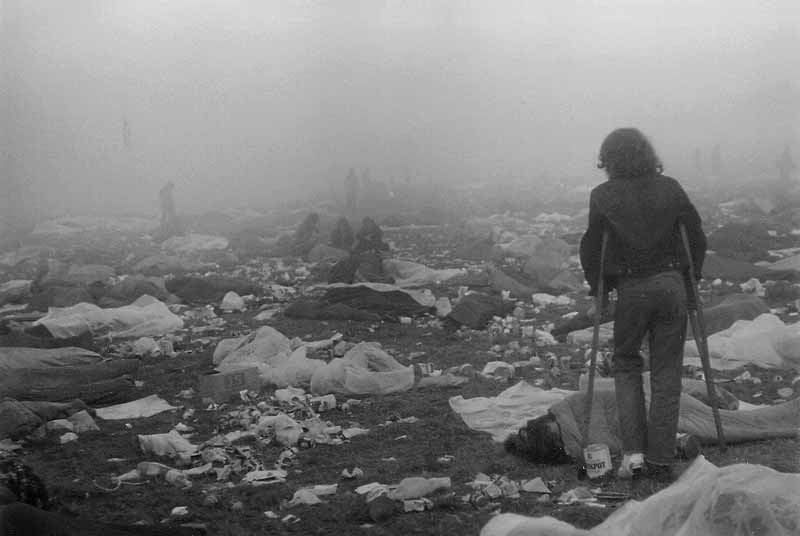 The crowd a mixture of hairy students in trench coats with their girlfriends in Afghans and wild-haired sheet metal workers on the drink looking to headbang themselves to oblivion. Rightly so.
The crowd a mixture of hairy students in trench coats with their girlfriends in Afghans and wild-haired sheet metal workers on the drink looking to headbang themselves to oblivion. Rightly so.
The late August three-dayer was an eclectic mixture, with less hard rock than punters had been accustomed to, and a not insignificant smattering of folk. Poor Tim Hardin, bloated and sick, played his ‘If I Were A Carpenter’ but found not all of the crowd as benign as his legendary performance of the same song at Woodstock. The endlessly inventive John Martyn, whose brilliant and sad, career-defining ‘Solid Air’ – the title track written for and about Nick Drake of course – had been released a few months previously, also put on a strong show with little more than an acoustic guitar and an echoplex… and the genius of Danny Thmpson on the double bass. RIP, John.
 George Melly, that great English eccentric was also booked and proved a hit, perhaps somewhat surprisingly, his blend of trad jazz and bonkers-ness going over well with a rock crowd not necessarily predisposed to outsized, camp jazz singers. Chris Barber, the legendary jazzer, also played.
George Melly, that great English eccentric was also booked and proved a hit, perhaps somewhat surprisingly, his blend of trad jazz and bonkers-ness going over well with a rock crowd not necessarily predisposed to outsized, camp jazz singers. Chris Barber, the legendary jazzer, also played.
Reading has never been a festival especially noted for its broad taste. I (writes Al T) remember going there in 1994, and seeing Ice Cube (!) last but one on the Saturday – near 15 years before the hoo-ha about whether Jay Z was an appropriate Glastonbury headliner. The crowd, and the former NWA frontman, really didn’t know what to make of each other. Reading, of course, is also famous for its bottling off of, well, almost anyone really. Apparently the ones that really hurt are the ones full of still-warm bladder contents. Poor old Bonnie Tyler. And 50 Cent. You shouldn’t laugh.
 Anyway, back to 1973, and the crowd wanted to see blues rock, and that is what Rory Gallagher gave them on the Friday night. The Cork man was on peak form, full of energy and drive – and unseen material from his forthcoming Tattoo album. He was without doubt the Friday highlight, and maybe the weekend as a whole. Commander Cody and His Lost Planet Airmen gave great value with their rockabilly, especially on that excellent monument to low times in the highlife, ‘Down To Seeds And Stems Again’.
Anyway, back to 1973, and the crowd wanted to see blues rock, and that is what Rory Gallagher gave them on the Friday night. The Cork man was on peak form, full of energy and drive – and unseen material from his forthcoming Tattoo album. He was without doubt the Friday highlight, and maybe the weekend as a whole. Commander Cody and His Lost Planet Airmen gave great value with their rockabilly, especially on that excellent monument to low times in the highlife, ‘Down To Seeds And Stems Again’.
Cometh the Saturday, cometh The Quo. In the special guest role, they opened for Rod and company. Rossi and Parfitt were well on their way by then – ‘Piledriver’ had set the formula for their hard boogie sound that would propel them into the strata of the rock super-rich. In fact, it was the album released just a few weeks after Reading, September’s ‘Hello!’ that would give them their first UK album number one.
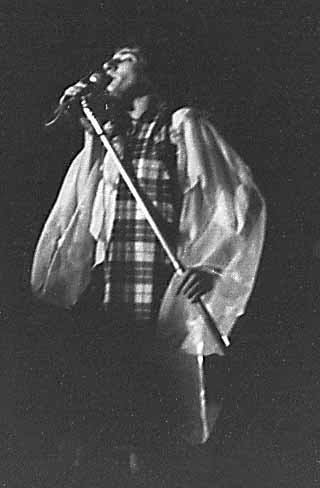 Saturday night’s headliners were Rod and The Faces, the biggest draw of the weekend – and the magnet for a huge group of football scarf-wearing fans. Clad in Tartan scarf, Rod The Mod opened up by kicking footballs into the crowd as he always did. Laddishness was in full force as per usual but though The Faces were a fine band, and one of the best live acts of the era, this maybe was not one of their best gigs.
Saturday night’s headliners were Rod and The Faces, the biggest draw of the weekend – and the magnet for a huge group of football scarf-wearing fans. Clad in Tartan scarf, Rod The Mod opened up by kicking footballs into the crowd as he always did. Laddishness was in full force as per usual but though The Faces were a fine band, and one of the best live acts of the era, this maybe was not one of their best gigs.
They had been together for the best part of four years by then, and superstardom was beckoning for their Rodney, whose solo career – 1971 saw him achieve massive success with ‘Maggie May’ and 1972’s utterly brilliant album Never A Dull Moment (one of rock’s forgotten classics) – was eclipsing that of the band, even though, ironically, the Faces played on most of his solo stuff anyway. The summer of 1973 saw the release of his greatest hits Sing It Again Rod - the cover was a die-cut whiskey glass. The Faces were a beer drinking band, but Rod was already on the shorts - that was how it was seen by the rock press at the time anyway. Like drinking shorts and wine is a socially aspirational way to get mullered!
Nevertheless, it was a decent show – and, in terms of the fans, their vibe and the attitude – a good example of how the rock and roll aesthetic would later mutate into a punk sneer.
_files/220px-Genesis_Group.jpg) Very much not punk at all were Sunday night’s headliners, Genesis. An immensely elaborate stage set took over two hours to put up, but eventually Peter Gabriel appeared in that mad ‘pyramid-with-eyes’ thing that heralded their magnificent Arthur C Clarke-inspired ‘Watcher Of The Skies’. Little green men aside, though, these were serious musicians, at a creative peak, and they put on a fine, layered musical feast.
Very much not punk at all were Sunday night’s headliners, Genesis. An immensely elaborate stage set took over two hours to put up, but eventually Peter Gabriel appeared in that mad ‘pyramid-with-eyes’ thing that heralded their magnificent Arthur C Clarke-inspired ‘Watcher Of The Skies’. Little green men aside, though, these were serious musicians, at a creative peak, and they put on a fine, layered musical feast.
As the festival program of the day declared of Gabriel, “there’s got to be something spiritual, perhaps evil, about a man who has got seven cats.” And indeed there probably is.
Melody Maker called their show “startling”, but they was plenty more to them than just the portentous stage sets. They played ‘The Musical Box’, ‘The Return of the Giant Hogweed’ and ‘Supper’s Ready’, which came in at a punchy 23 minutes. This was Genesis as pioneers of new music; a staggeringly original period for the band as they set about creating a brand new aural experience.
So that was Reading 1973: gay jazz singers, football scarves, Gabriel on alien invasion and Rory playing the living daylights out of a battered Strat. Not a bad way to spend a weekend.
football scarves, Gabriel on alien invasion and Rory playing the living daylights out of a battered Strat. Not a bad way to spend a weekend.
There’s a live album of the show but its a bit inadequate really, featuring Rory doing ‘Hands Off’ – brilliant, Strider, Greenslade, Quo, The Faces, Andy Bown, Lesley Duncan and Tim Hardin.
The full line up across the three days was this…
A J Webber who?
Alex Harvey SAHB. They released Next this year – a stone cold classic album
Alquin eh?
Andy Bown – top notch jazz rocker now forgotten
Ange – never ‘eard of ya
Capability Brown – a great Charisma label band who did Tull-ish style rock. Did a great cover of ‘Rare Bird’s Sympathy’ and The Dan’s ‘Midnight Cruiser’
Chris Barber Band – 50s jazzer
Clare Hammill – she was from Middlesbrough you know. Wasn’t she later, bizarrely, in some weird incarnation of Wishbone Ash?
Commander Cody – whacko rockabilly outfit with great album covers.
Dave Ellis – anonymous Dave as we like to call him.
Embryo – if you say so lads
Faces – the famous Faces
Fumble – nah, don’t know them
Genesis – ah yes
George Melly – goodness me
Greenslade – Greenslade were great keyboard-led prog and even had Roger Dean album covers. Dave Greenslade went on to do loads of TV theme music.
Jack the Lad – spin off from Lindisfarne. Beer, fiddles and sing-a-longs. Excellent.
Jimmy Horowitz Orchestra – who he?
Jimmy Witherspoon – old blues man
Jo’Burg Hawk – Another Charisma label band. From South Africa
John Hiseman’s Tempest – Ah, the beginnings of jazz rock fusion here with Holdsworth on the first album and (I think) Clem Clempson on the second. Great for noodle lovers.
John Martyn and Danny Thompson - stoned immaculate I should think.
Lesley Duncan – folkyness
Lindisfarne – Geordie folk rock. They were magnificent - their first three albums are classics
Magma – Christian Vander's madness - he inveted his own language!
Mahatma – I’m guessing they were hippies
Medicine Head – long-forgotten but excellent duo doing that folk/rock hybrid. They even had hit singles.
PFM – Italian prog rock. Oh yes. Chocolate Kings is a stunning album; they were on ELP's Manticore label.
Quadrille – I bet there was four of them
Riff Raff – sounds like a punk band
Rory Gallagher - The Man
Roy Buchanan – legendary telecaster technician. Get his live albums and be amazed
Spencer Davis – R & B old school style
Stackbridge – came on stage with rhubarb for some reason.
Status Quo – Down, down deeper and down
Stray Dog – Now, Stray were a great band. Not sure who Stray Dog were though
Strider – 2nd division-coming-to-your-local-small-venue-every 6-months type touring rock band. Good but not great
Tansavallian Presidency – if you say so squire.
Tim Hardin – folk legend.





No comments:
Post a Comment